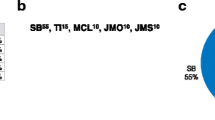Abstract
A simple tool is provided to assist researchers in assessing contributions to a scientific publication, for ease in evaluating which contributors qualify for authorship, and in what order the authors should be listed. The tool identifies four phases of activity leading to a publication—Conception and Design, Data Acquisition, Analysis and Interpretation, and Manuscript Preparation. By comparing a project participant’s contribution in a given phase to several specified thresholds, a score of up to five points can be assigned; the contributor’s scores in all four phases are summed to yield a total “contribution score”, which is compared to a threshold to determine which contributors merit authorship. This tool may be useful in a variety of contexts in which a systematic approach to authorial credit is desired.
Similar content being viewed by others
Notes
Of course, the number of citations the individual’s papers have accumulated serves as a useful metric for evaluating the importance of the individual’s work, but we set that aside as a secondary consideration for this paper.
This presumes the convention in which the first author is the one who played the most substantial role in performing the research, and the last author is the principal investigator, the author who played the most substantial role in supervising the research, see, e.g., (Strange 2008) and (Bennett and Taylor 2003).
References
Ahmed, S. M., Maurana, C. A., Engle, J. A., Uddin, D. E., & Glaus, K. D. (1997). A method for assigning authorship in multi-authored publications. Family Medicine, 29, 42.
American Chemical Society. (2012). Ethical guidelines to publication of chemical research. Washington: ACS Publications.
Belwalkar, B., & Toaddy, S. (2014). Authorship determination scorecard. American Psychological Society. http://www.apa.org/science/leadership/students/authorship-determination-scorecard.pdf.
Bennett, D. M., & Taylor, D. M. (2003). Unethical practices in authorship of scientific papers. Emergency Medicine, 15, 263.
Bhopal, R. S., Rankin, J. M., McColl, E., Stacy, R., Pearson, P. H., Kaner, E. F. S., et al. (1997). Team approach to assigning authorship order is recommend (letter to the editor). British Medical Journal, 314, 1046.
Bird, S. J. (1997). Authorship under review. Science and Engineering Ethics, 3, 235.
Clement, T. (2014). Authorship matrix: A rational approach to quantify individual contributions and responsibilities in multi-author scientific articles. Science and Engineering Ethics, 20, 345.
Gaeta, T. J. (1999). Authorship ‘law’ and order. Academic Emergency Medicine, 6, 297.
Greenland, P., & Fontanarosa, P. B. (2012). Ending honorary authorship. Science, 337, 1019.
ICMJE. (2013). Recommendations for the conduct, reporting, editing, and publication of scholarly work in medical journals. International Committee of Medical Journal Editors.
Kosslyn, S. (2002). Criteria for authorship. Retrieved from http://isites.harvard.edu/fs/docs/icb.topic562342.files/authorship_criteria_Nov02.pdf.
Loui, M. (2006). Commentary on an analytical hierarchy process model to apportion co-author responsibility. Science and Engineering Ethics, 12, 567.
NIH. (2007). Guidelines for the conduct of research in the intramural research program at NIH. Bethesda, MD: National Institutes of Health.
Paneth, N. (1998). Separating authorship responsibility and authorship credit: A proposal for biomedical journals. American Journal of Public Health, 88, 824.
Pichini, S., Pulido, M., & Garcia-Algar, O. (2005). Authorship in manuscripts submitted to biomedical journals: An author’s position and its value. Science and Engineering Ethics, 11, 173.
Rennie, D., Yank, V., & Emanuel, L. (1997). When authorship fails—A proposal to make contributors accountable. Journal of the American Medical Association, 278, 579.
Resnik, D. B. (1997). A proposal for a new system of credit allocation in science. Science and Engineering Ethics, 3, 237.
Schmidt, R. H. (1987). A worksheet for authorship of scientific articles. Bulletin of the Ecological Society of America, 68, 8.
Sheskin, T. J. (2006). An analytic hierarchy process model to apportion co-author responsibility. Science and Engineering Ethics, 12, 555.
Slone, R. M. (1996). Coauthors’ contributions to major papers published in the AJR: Frequency of undeserved coauthorship. American Journal of Roentgenology, 167, 571.
Smith, R. (1997). Authorship: Time for a paradigm shift? British Medical Journal, 314, 992.
Smith, E., & Williams-Jones, B. (2012). Authorship and responsibility in health sciences research: A review of procedures for fairly allocating authorship in multi-author studies. Science and Engineering Ethics, 18, 199.
Steneck, N. H. (2007). ORI introduction to the responsible conduct of research. Washington, D.C.: U.S. Department of Health and Human Services.
Strange, K. (2008). Authorship: Why not just toss a coin? American Journal of Physiology-Cell Physiology, 295, C567.
Tarnow, E. (1999). The authorship list in science: Junior physicists’ perceptions of who appears and why. Science and Engineering Ethics, 5, 73.
Tscharntke, T., Hochberg, M. E., Rand, T. A., Resh, V. H., & Krauss, J. (2007). Author sequence and credit for contributions in multi-authored publications. PLoS Biology, 5, e18.
Vicens, Q., & Bourne, P. E. (2007). Ten simple rules for a successful collaboration. PLoS Computational Biology, 3, e44.
Winston, R. B, Jr. (1985). A suggested procedure for determining order of authorship in research publications. Journal of Counseling and Development, 63, 515.
Author information
Authors and Affiliations
Corresponding author
Rights and permissions
About this article
Cite this article
Warrender, J.M. A Simple Framework for Evaluating Authorial Contributions for Scientific Publications. Sci Eng Ethics 22, 1419–1430 (2016). https://doi.org/10.1007/s11948-015-9719-0
Received:
Accepted:
Published:
Issue Date:
DOI: https://doi.org/10.1007/s11948-015-9719-0



